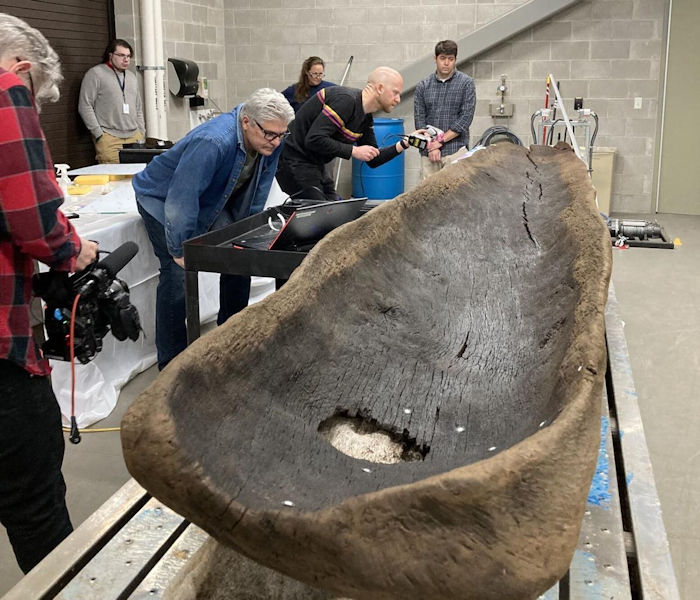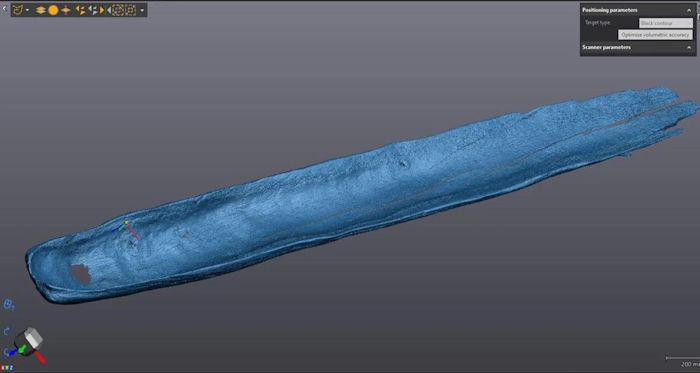Jan Bartek – AncientPages.com – Scientists are hopeful conducted high-tech scans will reveal some secrets of an ancient canoe discovered in Wisconsin, North America. The canoe was brought to the surface of Lake Mendota last November. Based on the results from the first studies, scientists have confirmed this is the oldest intact boat ever found in Wisconsin waters.
Carbon dating indicates that the vessel is approximately 1,200 years old and was in use around A.D. 800, centuries before European arrival.

The 1,200-year-old canoe was discovered in Lake Mendota, Wisconsin. Credit: Wisconsin Historical Society
The canoe, located in 27 feet of water about 100 yards off the Shorewood Hills shoreline, was discovered by Tamara Thomsen, who was on a recreational dive but is also a maritime archaeologist with the Wisconsin Historical Society.
“The dugout canoe found in Lake Mendota is a significant artifact of the continuum of canoe culture in the Western Great Lakes region,” said Christian Overland, the Ruth and Hartley Barker Director & CEO for the Wisconsin Historical Society. “By taking action to preserve this canoe we are protecting a piece of history for future generations. The canoe is a remarkable artifact, made from a single tree, that connects us to the people living in this region 1,200 years ago.
One of the goals of the 3D scans is to determine whether the 15-foot-long wooden canoe was constructed by the Mound builders who inhabited the Madison area a millennium ago and were ancestors of today’s Ho-Chunk Nation. According to the researchers who are examining the vessel, it does seem likely the canoe was used and built by the Mound builders.
“Seven net sinkers found in the boat suggest that it was a work canoe, used for a type of fishing previously only documented among cultures living along the shores of the Great Lakes,” the Journal Times reports.
Like all lakes worldwide, Lake Mendota holds the past, present, and even the future in its depths.
“Lakes reflect the land around them,” Steve Carpenter from the University of Wisconsin says. “They also reflect the ways that humans use that land and the ways we use the water.”
Often called “the most studied lake in the world,” Mendota is the birthplace of the field of limnology, the scientific study of inland waters. Thanks to a trove of long-term data gathered over more than 100 years by UW scientists like Steve Carpenter, the connection between Mendota and the humans who have interacted with it over time is unusually well understood.

A series of scans on the canoe includes a hole, at left, in one end of the boat. The scans show more details than can be seen with the naked eye. Credit: Wisconsin historical Society
“I want to make this the most studied canoe in the world. We want to use every resource available to learn as much as we can about this vessel to tell a variety of stories,” Wisconsin State Archaeologist James Skibo said.
“This canoe is a very complex shape, and it was created by hand,” Skibo said. “So there was a person, an engineer, that built this 1,200 years ago. He or she was probably one of the original early ‘makers.’ To me, documenting that work is a great use for 3D scanning.
“I really enjoy working in interdisciplinary settings,” Lennon Rodgers, who directs the Grainger Engineering Design and Innovation Laboratory, and conducted the scans said in a statement. “I hung out with these archaeologists and historians and I could see they think differently from engineers. That’s why I’m attracted to these projects. They have a fresh, different approach to problem-solving, and we as engineers can work with them in a complementary way.”
The high-resolution scans captured marks and textures not apparent to the naked eye, and the software of the scanning devices was used to further analyze the surface by taking cross-sections and focusing on specific features.
See also: More Archaeology News
The Journal Times informs that “once the preservation process is completed, the canoe will likely go on display. But Skibo may use the scans to create a full-size replica in which visitors could sit, once the new Wisconsin History Center opens on Capitol Square at the top of State Street.
Skibo is also considering scans of other fragile archived artifacts and wants to use specially equipped drones to scan forests and fields in Wisconsin to uncover hidden effigy mounds and other historic sites.”
Written by Jan Bartek – AncientPages.com Staff Writer





